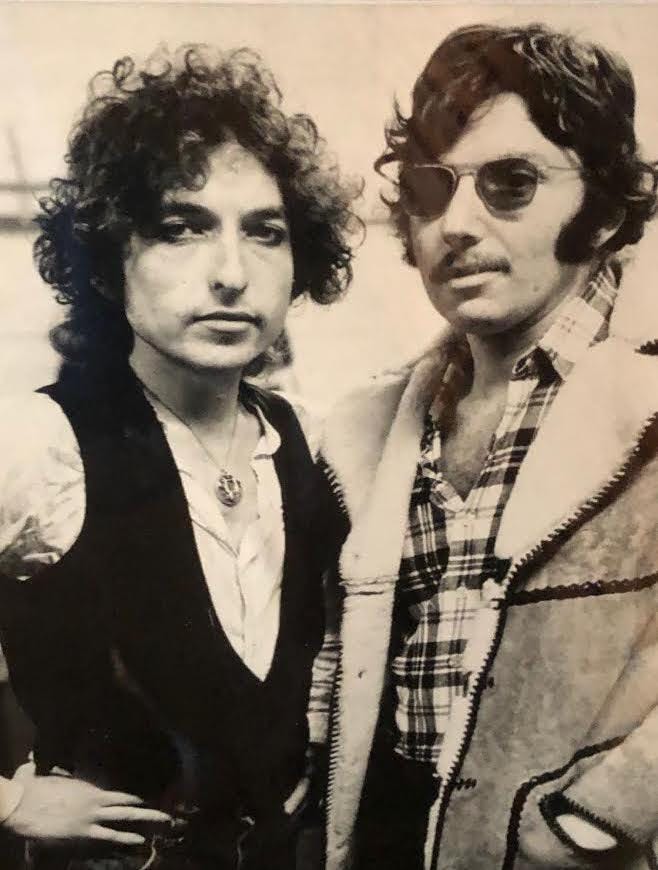Interview: Louie Kemp, Rolling Thunder Producer and Bob Dylan's Childhood Friend
1975-12-04, Forum, Montreal, Quebec
Flagging Down the Double E’s is an email newsletter exploring Dylan shows of yesteryear. I’m currently writing about every show on the Rolling Thunder Revue. If you found this article online or someone forwarded you the email, subscribe here to get a new entry delivered to your inbox every week:
Update June 2023: This interview is included along with 40+ others in my new book ‘Pledging My Time: Conversations with Bob Dylan Band Members.’ Buy it in hardcover, paperback, or ebook here!
As I mentioned in the last newsletter, we’re going to conclude our look back at Bob Dylan’s Rolling Thunder Revue with a trio of interviews. Today, we kick it off with the man who had more to do with keeping Rolling Thunder rolling than just about anyone: Louie Kemp.
Kemp was credited as the producer of the Rolling Thunder Revue, but that title didn’t begin to encompass his job description. He oversaw just about everything behind-the-scenes, from organizing the tour route to running the day-to-day activities on the road. He came to this role with exactly zero experience in the music business. He was, as he puts it, “a fish guy,” founding the extremely successful Louis Kemp company (which continues today after he sold it a few years back).
Dylan hired him not in spite of his lack of music-biz experience, but because of it. Bob knew he could trust his childhood friend to always have his back. As Louie puts it at one point in our interview, “I could play as hardball as I wanted because, [after Rolling Thunder], I was going back to the fish business.” Here’s my conversation with Louie Kemp:

Before we get to Rolling Thunder, I read in your book that you saw maybe the first ever Bob Dylan concert, of a sort: Talent Night at Herzl Camp in Minnesota, 1954. What can you tell me about that Bobby Zimmerman performance?
Talent Night is where any of the campers that wanted could exhibit whatever talent they had. Kids would dance, sing Jewish songs, all kinds of stuff. Bobby did a rock and roll exhibition that night. He covered the singers of the day who had an effect on him. Chubby Checker. Little Richard. Jerry Lee Lewis.
You just listed a couple of pianists. Was that his main instrument then?
We had a piano at Herzl Camp in the recreation room and he would go there and pound on it and sing Jerry Lee Lewis a lot, but he also had his guitar. He carried that with him and he would play that as well.
One other very early show you mention is him playing guitar on top of a building for the entire day.
That was about three years later, in '57, our last year there. Traditionally they have a day at the camp where the campers would trade places with counselors to give the campers a chance to exhibit some responsibility. Bobby chose to be the music director of the camp. He spent the whole day on top of the roof of the Activity Hall. He was up there with his guitar and he sang the whole time. Campers and counselors would walk by and listen to him. Our friend Larry Kegan and I spent a lot of time cheering him on and bringing him water. He was the original Fiddler on the Roof.
Jumping way forward, you lost touch for a while until the 1974 tour with The Band. Tell me how you got involved in that.
In '72, his mother had run into me downtown and said, "Bobby would like to see you if you ever get to New York.” She gave me his number and I called him; that's how we got back together. I went to Durango, hung out with him when he was shooting the movie and writing the music, including “Knockin' On Heaven's Door,” which he played for me one-on-one before it ever came out.
We were hanging out in the latter part of '73 in LA, and he said, "I'm going to do this tour. If you want to come with me, you're more than welcome." I did and I spent the whole tour with him in '74.
Did you have an official role like you would the next year ,or were you just along as a friend?
I was strictly there as Bobby's friend. Once Bill Graham figured that out, he put a rocking chair onstage right next to Levon Helm, where I watched every concert. Best seat in the house.
In fact, the phenomena of people lighting the lighters after [the band] went off stage, I might have been one of the closest people who could see it, sitting in my rocking chair prior to the encore. It was on the album cover of that tour.
What was the backstage vibe of the '74 tour? I feel like a lot of the Rolling Thunder story is that, in '74, it was these big generic arenas and greatest hits and he was dissatisfied. Did you feel that at the time?
No, it was such an amazing happening. As I recall, they had so many requests for tickets, they had to run a lottery to see who got the tickets. Off the top of my head, 12 million people sent their money to buy tickets for 600,000 seats. Both he and the band were into the music and the crowds responded amazingly. The whole thing was electrifying.
Keep reading with a 7-day free trial
Subscribe to Flagging Down the Double E's to keep reading this post and get 7 days of free access to the full post archives.


